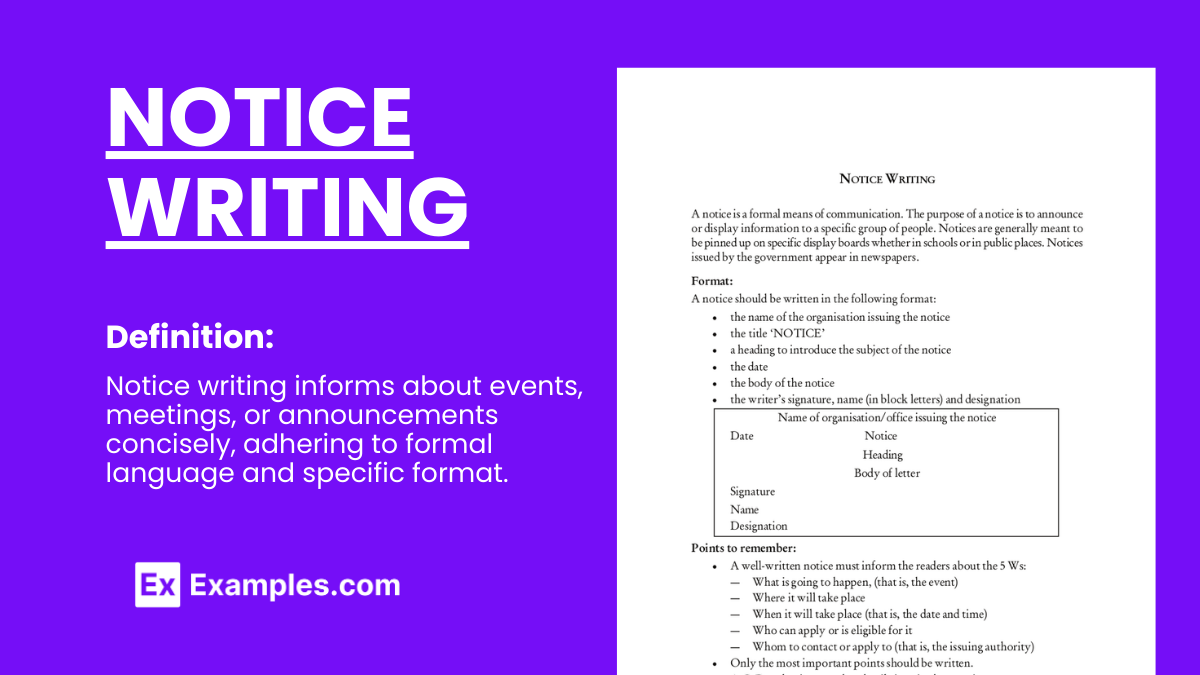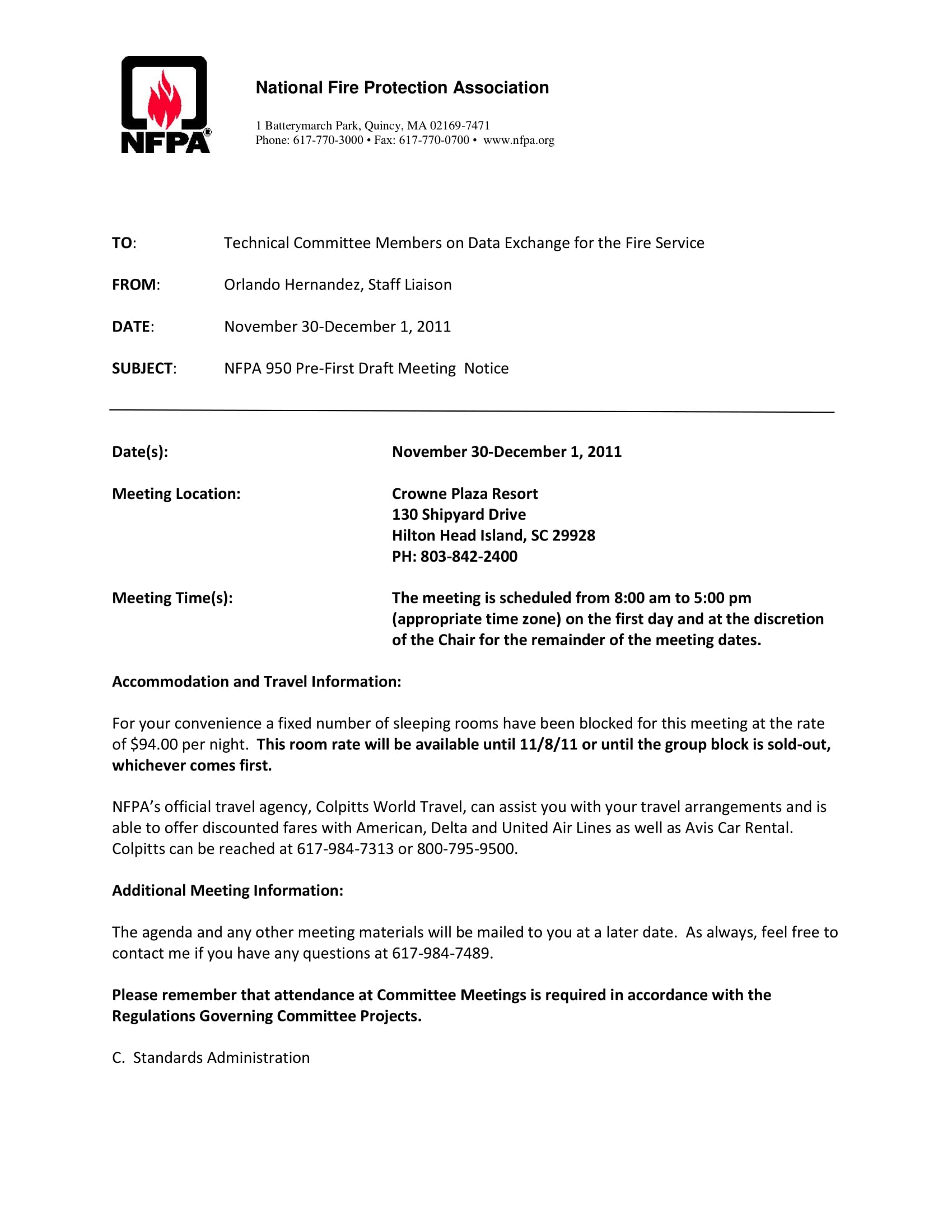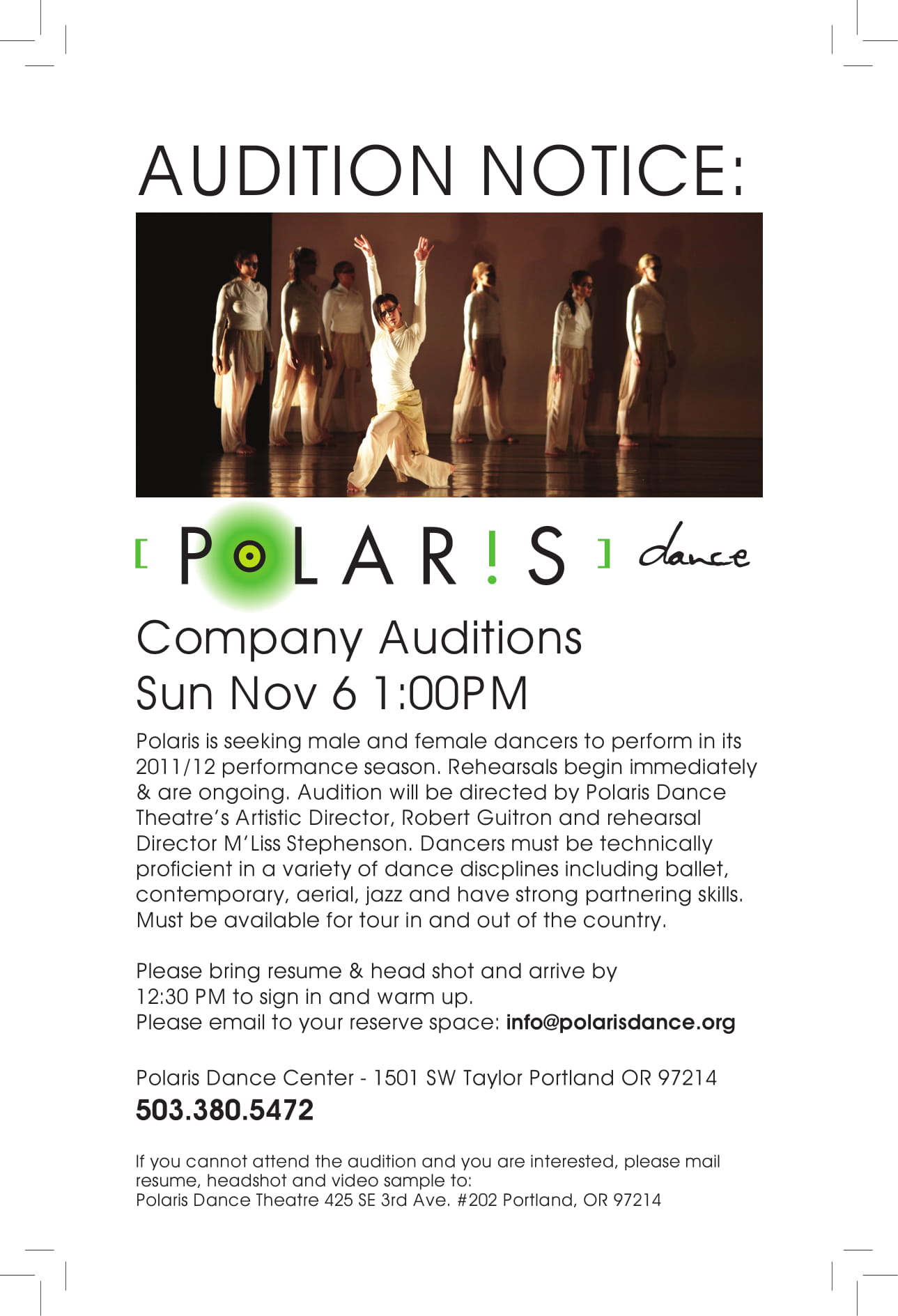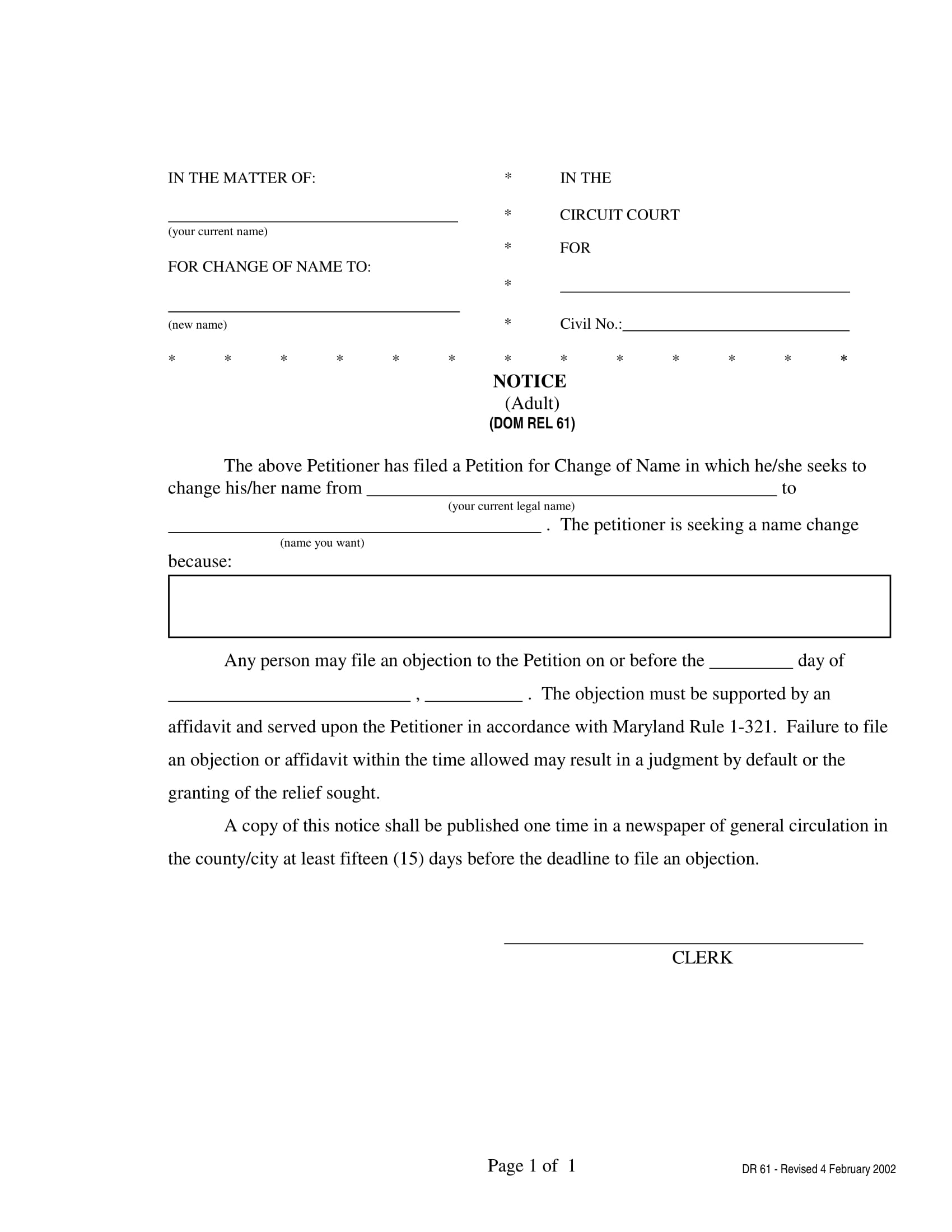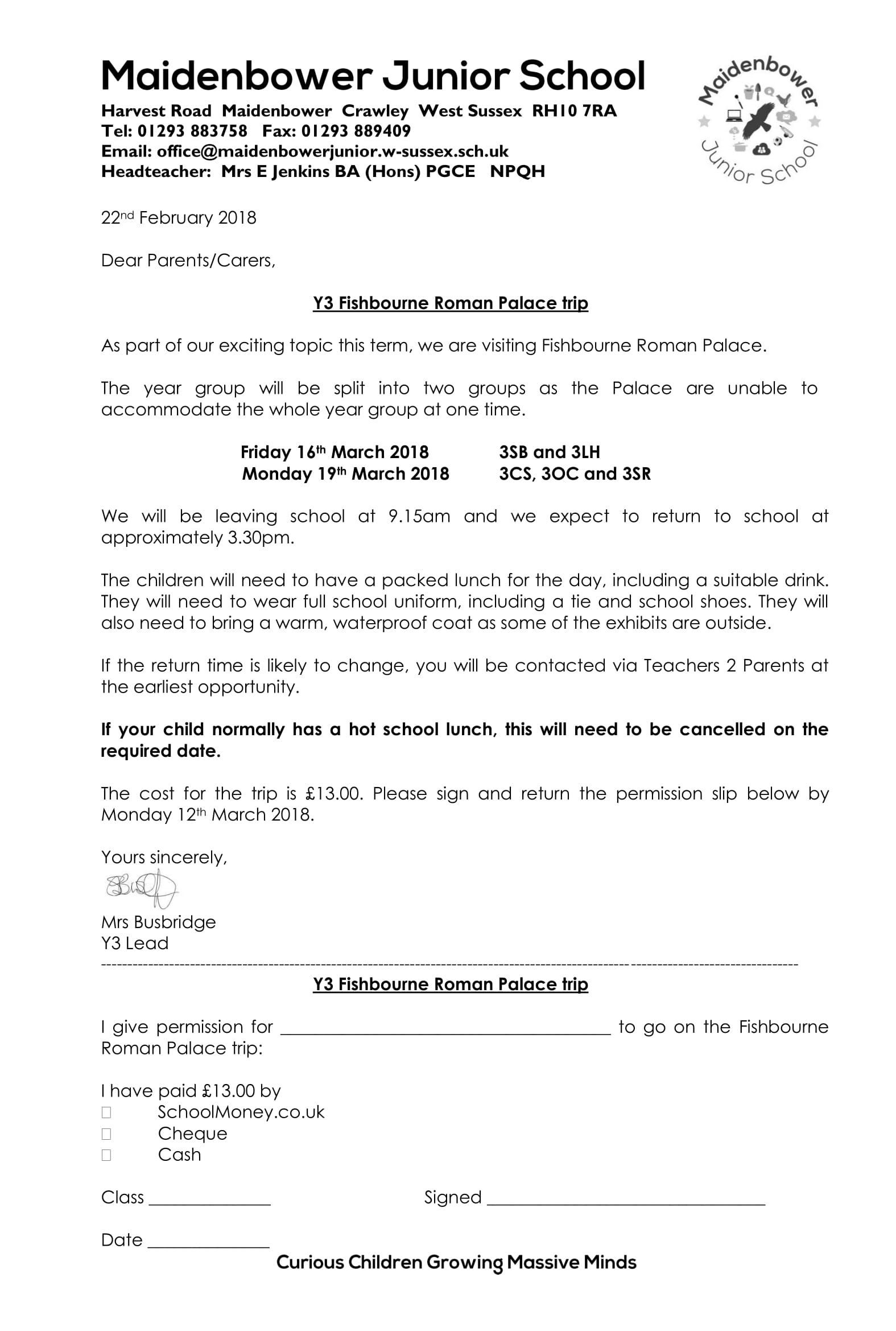18+ Notice Writing Examples to Download
There are many ways to inform people about a certain event that is about to happen. Announcements are the most common way of spreading information about what has happened, what is happening and what will happen. It can be done through TV and radio coverage, newspapers, simple posters, elegant flyers, etc.
With the rise of social media, establishments often broadcast their announcements through boosted Facebook posts or promoted posts on Twitter and Instagram. Social media has really opened a whole new avenue of announcing and making things known, even news outlets have their own pages and profiles on various platforms as they can reach a wide range of audiences through social media.
But, before the rampant use of social media for announcements, it has been a common practice – even until today, to post announcements on bulletin boards across campus or public spaces. However, how do you write these announcements or notices?
What is Notice Writing?
Notice writing involves crafting a concise and formal announcement or information intended for a specific group of people. Notices are used to inform, alert, or remind the intended audience about events, changes, or important activities. Typically, notices are straightforward and include essential details such as the purpose of the notice, date, time, venue (if applicable), and contact information. They are commonly posted on notice boards, published in newsletters, or circulated in digital format within organizations, schools, communities, or public spaces. The goal is to communicate the message clearly and efficiently, ensuring that the relevant information reaches the intended recipients promptly.
Notice Writing Format
Heading
- NOTICE
- This should be written at the top of the document, centered, and in bold to catch the reader’s attention.
Date
- The date when the notice is issued should be placed below the heading, aligned to the right.
Title
- A brief, descriptive title reflecting the purpose of the notice should be given after the date, centered and possibly underlined.
Body
- Introduction: A sentence introducing the purpose of the notice.
- Details: Key information such as the event date, venue, time, and other relevant details.
- Action Required: Any action that the readers need to take, like registering for an event or attending a meeting.
- Contact Information: Details of the person or office to contact for more information or clarifications.
Closing
- The notice often ends with a signature, name, and position of the person issuing the notice, followed by the name of the organization or department.
Example of Notice Writing
Free Download in Word Free Download in PDFNotice of School Annual Day Celebration
NOTICE
Date: March 1, 2024
Annual Day Celebration
The Prestige International School is delighted to announce the celebration of our Annual Day on March 15, 2024. This year’s theme, “Unity in Diversity,” aims to showcase the rich cultural tapestry of our community through a variety of performances and exhibitions.
Event Details:
- Date: Thursday, March 15, 2024
- Time: 5:00 PM to 8:00 PM
- Venue: School Auditorium, Prestige International School
The evening will feature performances by students across all grades, including dance, music, and drama, reflecting the diverse cultures that enrich our school community. Additionally, an art exhibition by the students will be held in the school foyer from 4:00 PM.
Parents, guardians, and family members are cordially invited to attend and enjoy the festivities. We encourage everyone to come and support our talented students. Refreshments will be served at the conclusion of the event.
For further inquiries or to volunteer for event organization, please contact Ms. Lydia Martin, Event Coordinator, at the school office or via email at events@prestigeschool.edu.
Issued by:
Mr. Aaron Smith
Principal, Prestige International School
Notice Writing for Class 8
Free Download in Word Free Download in PDFNOTICE
Date: March 1, 2024
Subject: Upcoming Science Fair
The Green Valley School is excited to announce the Annual Science Fair for the academic year 2023-2024. We invite all students from Class 8 to participate in this enlightening event. This is a fantastic opportunity to showcase your scientific curiosity and innovative projects.
Event Details:
- Date: March 15, 2024
- Time: 9:00 AM – 2:00 PM
- Venue: School Auditorium
- Theme: “Innovations for a Sustainable Future”
Guidelines for Participation:
- Interested students must register with their science teachers by March 5, 2024.
- Projects can be submitted individually or in teams of up to three members.
- All projects must adhere to the theme and be original work.
For further inquiries, please contact Mr. Aiden Clark, Science Department Head, or visit the school’s notice board.
Let’s make this event a grand success with your enthusiastic participation!
Issued by:
Ms. Eleanor Rigby
Principal, Green Valley School
Two Weeks Notice Writing Example
Free Download in Word Free Download in PDFDate: March 1, 2024
Subject: Resignation Notice
Dear Mr. Hudson,
I am writing to formally announce my resignation from my position as Graphic Designer at Creative Designs Ltd., effective two weeks from today, March 15, 2024. This decision comes after much consideration and is based on personal reasons that require my attention.
I would like to express my sincere gratitude for the opportunities for professional and personal development that you have provided me during the last three years. I have enjoyed working for the company and appreciate the support provided me during my tenure with the company.
Please let me know how I can assist during this transition and make it as smooth as possible. I am willing to help train my replacement or pass on my responsibilities appropriately.
Thank you again for the opportunity to work at Creative Designs Ltd. I look forward to staying in touch, and I hope our paths cross again in the future.
Sincerely,
[Your Name]
Contents to Include in a Notice
- Name of issuing organization, institution or office.
- Date of notice issuance.
- To make it clear, the heading “Notice” should be indicated.
- An eye-catching heading or headline to catch the immediate attention of the audience.
- The purpose of the notice.
- Details regarding the purpose of the notice.
- Authorized signatory.
Notice Writing for Class 5
Objective: The goal Notice Writing for Class 5 is to inform Class 5 students about an event or important announcement relevant to their grade. This could be about a field trip, a class project, a sports day, or a cultural event organized specifically for their age group.
How to Write: Writing a notice for Class 5 involves crafting a brief and clear message that is easily understandable by young students. The notice should start with a bold title, such as “NOTICE,” followed by the date of issuance. It’s essential to mention the purpose of the notice in a straightforward manner, outlining any event or important information relevant to the class. Include all pertinent details like the event date, time, venue, and any specific instructions or items the students need to bring or prepare. Using simple language and short sentences will ensure the notice is accessible to the young audience. Finally, conclude with a call to action or a point of contact for further inquiries, ensuring clarity and effectiveness in communication.
Notice Writing for Class 6
Objective: The aim of Notice Writing for Class 6 is to convey crucial information to Class 6 students regarding educational activities, such as workshops, competitive exams, or any special classroom activities designed for their curriculum enrichment.
How to Write: When crafting a notice for Class 6, it’s important to communicate in a concise yet informative manner to accommodate the comprehension levels of students at this stage. The notice should prominently feature the word “NOTICE” at the top, accompanied by the issuing date. Clearly define the purpose of the notice, detailing any upcoming events or important notifications specific to Class 6. Essential information, including the event’s date, time, location, and any preparation required by the students, should be straightforward. Language used should be simple, clear, and direct, making it easy for students to understand. End with instructions on whom to contact for more details, providing a straightforward avenue for inquiries.
Notice Writing for Class 7
Objective: The goal of Notice Writing for Class 7 is to inform Class 7 students about significant educational events, such as science fairs, art exhibitions, or guest speaker sessions, which are instrumental in broadening their academic and extracurricular horizons.
How to Write: To effectively draft a notice for Class 7, begin with a bold “NOTICE” heading, followed by the date it is published. The message should succinctly outline the event or announcement, focusing on relevance to Class 7 students. Be sure to include vital details like the date, time, and venue of the event, along with any specific instructions or materials students might need. The language should be straightforward and accessible, ensuring it resonates with the target age group. Conclude with a call to action, such as a registration deadline or a contact person for further information, facilitating clear communication and engagement.
Notice Writing for Class 9
Objective: This Notice Writing for Class 9 aims to update Class 9 students about important academic deadlines, upcoming examinations, or special educational programs that are crucial for their preparation for higher education.
How to Write: Crafting a notice for Class 9 requires a clear and engaging approach, beginning with the word “NOTICE” in bold and the date of issuance. Explain the purpose of the notice, focusing on information that impacts the academic journey of Class 9 students. Include critical details such as deadlines, examination dates, or program schedules, and explicitly mention any action required from the students. Use language that is both clear and slightly more sophisticated, acknowledging the mature comprehension level of Class 9 students. End with a specific call to action, providing contact details for students to seek further information or clarification.
Notice Writing for Class 10
Objective: The purpose of Notice Writing for Class 10 is to communicate to Class 10 students about pivotal events such as board exam preparation sessions, career counseling workshops, or mandatory school functions, which are essential for their academic and future career planning.
How to Write: Notice writing for Class 10 involves a formal yet accessible tone, starting with a “NOTICE” heading and the date. The body of the notice should clearly outline the event or information, tailored to the needs and expectations of Class 10 students. Key details such as event dates, times, and venues, along with specific preparations or documents required, should be clearly stated. The language should be precise and mature, suitable for students at the cusp of completing their secondary education. Conclude with a direct call to action and provide a contact point for students to address their queries or concerns, ensuring the notice is both informative and actionable
Notice Writing for Class 11
Objective: The goal of Notice Writing for Class 11 is to inform Class 11 students about academic opportunities, college preparation seminars, career guidance sessions, or other events specifically tailored to their immediate needs and future aspirations.
How to Write: Crafting a notice for Class 11, much like Notice Writing for Class 6, requires clear and concise communication, tailored to engage students who are at a critical juncture in their academic journey. Begin with “NOTICE” in bold and the date of issuance. Clearly state the purpose, focusing on the relevance to Class 11 students, such as university application workshops or subject-specific advanced learning opportunities. Detail the event’s date, time, venue, and any preparatory actions needed, like prior registration or research. The language should be straightforward but can incorporate more sophisticated vocabulary reflective of their higher grade level. Conclude with actionable advice and a point of contact for further details, facilitating a seamless flow of information.
Notice Writing for Class 12
Objective: The objective of Notice Writing for Class 12 is to communicate crucial information to Class 12 students about upcoming exams, scholarship opportunities, college application deadlines, or graduation ceremonies, addressing their immediate academic and future career planning needs.
How to Write: Notice Writing for Class 12 should follow a format similar to Notice Writing for Class 7, with a focus on clarity and directness, considering the audience’s maturity and imminent transition out of school. Start with a bold “NOTICE” and the posting date. Clearly describe the event or announcement, emphasizing its significance to final-year students and including pertinent details like dates, times, and locations. Instructions or requirements should be outlined clearly, using language that resonates with their advanced understanding. The notice should end with a clear call to action and contact information for inquiries, ensuring students have the resources they need to act or prepare accordingly.
Notice Writing for School
Objective: The aim of Notice Writing for School is to communicate essential information to the entire school community, including students of all grades, staff, and parents, about events, policy changes, or important reminders that impact the school environment.
How to Write: Notice Writing for School requires a broad approach that is inclusive and understandable by a diverse audience. Start with “NOTICE” in bold and include the date. The message should succinctly state the purpose, appealing to the whole school community, whether it’s announcing a school-wide competition, a health and safety protocol update, or a community service project. Details such as dates, times, and actionable steps should be clearly outlined, ensuring accessibility to all reading levels. End with a point of contact for further questions, mirroring the inclusive and comprehensive nature of the school community.
College Notice Writing
Objective: The purpose Of College Notice Writing is to inform college students and faculty about academic deadlines, seminars, campus events, or administrative notices that are pertinent to the collegiate environment.
How to Write: College Notice Writing involves addressing a mature audience with specific academic and extracurricular interests. Begin with “NOTICE” in bold, followed by the date. The announcement should directly state its relevance to the college community, including detailed information on academic seminars, cultural fests, or registration deadlines. The language can be more formal and detailed, reflecting the audience’s higher education level. Include specific instructions, deadlines, and contact details for further inquiries, ensuring the college community is well-informed and prepared to engage with the event or information.
Informal Notice Writing
Objective: The goal of Informal Notice Writing is to create an engaging and friendly announcement for informal events or gatherings, such as a workplace party, a community picnic, or a friend group meetup.
How to Write: Informal Notice Writing, unlike the formal approach in Office Notice Writing, adopts a casual and inviting tone. Start with a catchy heading that grabs attention. The date of the notice should still be included for reference. Describe the event in a light-hearted manner, emphasizing fun and camaraderie, and include all necessary details like the location, date, time, and what attendees should bring or expect. The language should be conversational and welcoming, encouraging participation. Conclude with a note on how to RSVP or who to contact for more information, keeping the tone friendly and open.
Office Notice Writing
Objective: Office Notice Writing is to relay important information to employees regarding policy updates, corporate events, HR announcements, or health and safety measures within a professional setting.
How to Write: Office Notice Writing demands a clear, concise, and professional tone. Begin with “NOTICE” in bold, followed by the date, to immediately signal the importance. State the purpose of the notice, directly addressing the office employees with relevant information such as policy changes, event details, or health advisories. Include specific details like effective dates, locations for corporate events, and actionable steps employees need to take. The language should be formal yet accessible, ensuring all employees understand their roles and responsibilities. Conclude with contact information for employees to seek clarification, mirroring the formal structure and direct approach typical of professional environmente.
Format for Official/Non-Official Meetings’ Notice
- Title/Heading: Start with “NOTICE” in bold letters at the top.
- Date: Include the current date of issuing the notice.
- Subject: Briefly state the purpose of the notice, e.g., “Meeting Notice.”
- Body:
- Introduction: Mention the call for the meeting and its nature (official or non-official).
- Details: Specify the meeting date, time, venue, and agenda or topics to be discussed.
- Action Required: If applicable, mention any preparation or documents participants should bring.
- Closing:
- Contact Information: Provide details for RSVP or queries.
- Signature: Include the name and position of the person issuing the notice.
Format for Events’ Notice
- Title/Heading: Begin with “NOTICE” in bold at the top.
- Date: The date the notice is issued.
- Event Name: Clearly state the name of the event.
- Body:
- Introduction: Brief introduction or purpose of the event.
- Event Details: Include key information such as the event date, time, venue, and any specific theme or dress code.
- Participation Details: Mention how to participate or register, and if there are any fees or requirements.
- Additional Information: Provide any other relevant details (e.g., guest speakers, special instructions).
- Closing:
- Contact Information: For queries or further details.
- Signature: Name and position of the person issuing the notice, if applicable.
Depending on specific occasions, it is acceptable to use background images, logos or graphic representing the event.
Format for Lost and Found Notice
- Title/Heading: Start with “LOST AND FOUND NOTICE” in bold letters at the top.
- Date: Include the date the notice is being posted.
- Description:
- Introduction: Indicate whether it is a lost item notice or a found item notice.
- Detailed Description: Provide a detailed description of the lost or found item (color, brand, type, distinctive marks/features).
- Date and Location: Mention where and when the item was lost or found.
- Action Required:
- For lost items, request anyone who finds the item to contact you.
- For found items, request the owner to identify and claim the item.
- Contact Information: Provide your name, contact number, and any other relevant contact details.
- Reward (Optional): Mention if there is a reward for returning the lost item.
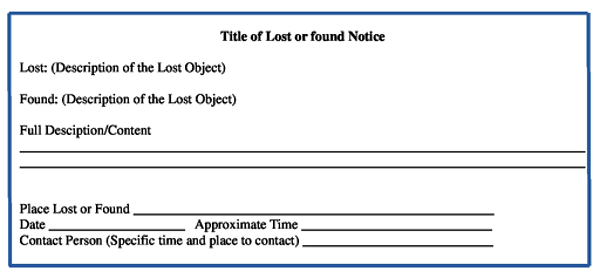
Format for Name Change Notice
- Title/Heading: Start with “NOTICE OF NAME CHANGE” in bold letters at the top.
- Date: Include the date when the notice is being published or issued.
- Introduction:
- Briefly state your current name and the new name you will be adopting.
- Body:
- Reason for Name Change: Mention the reason for the name change (optional, based on privacy concerns).
- Effective Date: Specify the date from which the new name will be officially used.
- Legal Statement: A formal declaration that you are changing your name for all personal, professional, and legal purposes.
- Signature: Your signature (optional in a written notice but necessary for legal documents).
- Public Notification: State that this notice serves as a public declaration of your name change.
- Contact Information: Provide a way for individuals or institutions to contact you if needed (optional based on the nature of the notice).
Format for Future Tours/Fairs/Exhibitions/Camps’ Notice
- Title/Heading: Begin with a clear title such as “NOTICE” in bold, followed by the type of event (Tour/Fair/Exhibition/Camp).
- Date: Include the date of issuing the notice.
- Event Name: Clearly state the name of the tour, fair, exhibition, or camp.
- Body:
- Introduction: Brief introduction or purpose of the event.
- Event Details: Key information including the event date(s), time, venue, and any specific themes or highlights.
- Participation/Registration Details: Information on how to participate or register, including deadlines, fees (if any), and any prerequisites or materials needed.
- Additional Information: Any other relevant details such as guest speakers, special attractions, or what participants should bring.
- Closing:
- Contact Information: For further inquiries or details.
- Signature: Name and position of the person issuing the notice, if applicable.
Points to Remember in Notice Writing
- A good notice must effectively answer the 5 Ws question
- What is going to happen?
- Where will it take place?
- When will it take place?
- Who can apply or is eligible?
- Whom to contact or apply to
- The word “NOTICE” should be written at the top.
- Do not forget to indicate the organization, office, etc. issuing the notice.
- An appropriate heading is needed.
- Indicate when the notice was issued.
- Clarify the target audience of the notice.
- Only the important details should be written.
- Relevant details not included in the questions is acceptable to add.
- Use only short sentences that are grammatically correct.
- Use a passive voice as much as possible.
- The common word limit is between 40 to 50 words.
- Information disseminated in the notice should be factual and clear; it must not cause confusion and/or misunderstanding.
- It should be able to immediately attract the audiences’ attention. It should be catchy and attention-grabbing.
- Use bold letters, catchy slogans, striking words and phrases to increase attention-grabbing quality.
- Standard and commonly used abbreviations are allowed.

In the academe, students are required to practice writing notices. As the marking scheme for notice writing, the name of organization, “NOTICE,” heading and date as well as the content and language is equivalent to 2 marks. The name and designation of the person writing, and writing the notice inside a box is equal to 1/2 marks. It the writer exceeds the word limit by 2 or 3 words, 1/2 mark is then deducted. If the exceeding words are 4 or more, 1 mark is deducted. You may also see employee notice examples & samples
Notices serve as an important tool for communication. It is very common to read notices, especially concerning the government as it is used for transparency and spreading information to the public. It makes it easier for the responsible office to spread the information since it just posted in visible public areas or designated bulletin boards. You may also like separation notice examples & samples
Writing notices is an art but unfortunately, people have forgotten how to write formal notices. Although it can be somehow restricting, it is a good practice to measure the command in language and words. It can measure the writer’s ability to completely convey the information in such short sentences. Notices, are in fact, still very useful and an efficient source of information.
Characteristics of Notice Writing
A good and effective notice must have the following features:
1. Brief
A notice usually has a specific word count. It is common to adhere to the 40 to 50-word limit. The sentences in the notice should be short, concise but should express a complete thought. Repetition is prohibited and there is no need for an introduction. It is straight-to-the-point information; as it is a formal method of communication, it is expected to be direct and clear. It should leave no room for further query but should not compromise the word limit.
2. Complete
As mentioned above, it is a short piece of writing but still expresses a complete thought. Indicate the necessary information regarding the event like date, venue, fees, guests, prizes, etc. It should answer the 5 Ws and 1 H questions effectively and must not leave audiences with more questions instead of no questions. You may also check out work notice examples & samples
3. Authority
The authority in a notice is the individual, organization, office, etc. issuing the notice. The people responsible for the event should be indicated to make it clear that the notice is legitimate and valid. You may also see meeting notice examples & samples
4. Clarity
Avoid being vague about the information regarding the event. The purpose of the notice must be easily understood after just a quick read through the whole material. It must be crisp, straight-forward and direct.
5. Language
As it is a formal announcement, simple and formal language must be used. No need for flowery words in the notice. It must convey formality and clarity. You may also like appointment notice examples & samples
6. Clearly Stated Purpose
As mentioned earlier, it must contain the following information:
- Name of issuing organization, institution or office.
- Date of notice issuance.
- To make it clear, the heading “Notice” should be indicated.
- An eye-catching heading or headline to catch immediate attention of the audience.
- The purpose of the notice.
- Details regarding the purpose of the notice.
- Authorized signatory.
Elements of an Effective Notice Writing
An effective notice writing contains the four C’s, namely, conciseness, completeness, command, and clarity. Find out more about it below:
An effective notice is concise
It is important to keep the information in your notice to have a minimum number of words and usually, forty to fifty words are sufficient enough for your notice. You may also like two weeks notice examples & samples
The sentences you use to formulate your notice should be short, should have no repetitive or redundant content, and should be direct and straight to the point. What makes an effective notice is that it would leave no void or space for further inquiries without compromising the word count. You may also be interested in resignation notice.
An effective notice is complete
What is the point of putting up a notice that contains incomplete details? Your purpose then of posting or printing one will be defeated. Notices should always make sure that it would contain every single information your target readers or audience has to know. One indication that the notice you have created is complete is that it would answer the basic 5 Wh questions: who, what where, when, and whom. You may also see employee notice examples & samples
The content of your notice will be affected with the kind of event you are going to announce about. For example, you are going to create a notice for a meeting. If you are going to create a notice for your organization’s meeting, make sure you would include who the notice is for, what event is being announced, where it will be, when it will be held, and who should be contact when there are inquiries that the notice could not answer. Additionally, it would also include other necessary information that may not necessarily be answering the 5 Wh questions. You may also see notice examples in word.
An effective notice must possess command
Notices are authorized by someone who has, obviously, an authority to do so, therefore, you should ensure that you would include the name of the person in authority who is the one who issued the notice. It could be you if you are in authority, it could be the president of the organization, the principal of a school, the CEO of the company, the manager of a bank, or the secretary of the department. You may also like separation notice examples & samples.
The tendency when not including the name of the authority is that the target readers of the notice will not to heed to what is being written on the notice. An effective notice will become “an authority” itself and would have more credibility once it is signed by the person who authorized it. You may also be interested in Work Notice Examples & Samples.
On the other hand, the choice of text or language alone on your notice should have a strong command. Once you are able to have a strong and excellent command of the language you use, the more you become credible. You may also want to read more Notice Examples in PDF.
An effective notice should possess clarity
Another thing that would defeat the purpose of a notice is that it would not possess clarity. Once your notice would be ambiguous, the message you want to get across to your intended reader will not be clear to them at all. You may also want to know what an adverse action notice is.
For example, you posted a notice regarding an organization event and your notice lacks the specific information about when the event will take place and whom they should be contacting for further inquiries. Sure, you may have only included the date but you have not included the time, and you may also have included the name of the person your organization members would have to contact to in case they have inquiries but you were not able to include his or her contact number. However, how can your organization members attend the said event if it does not contain such pertinent information? One purpose of making use of a notice is that it could help in announcing certain information to people. How can you meet that purpose if your notice lacks the necessary and clear information? You will totally defeat the purpose of a notice. You may also see Copyright Notice Examples and Samples.
Now that you already know the important elements of notice writing, make sure that you will be applying what you have learned on the notice you are creating now. You may also refer to the notice writing examples that we have uploaded here in this article. These notice writing examples show a wide variety of how to write a notice. The following notice writing examples are also ready for download just in case you are still not yet ready to create your own.


